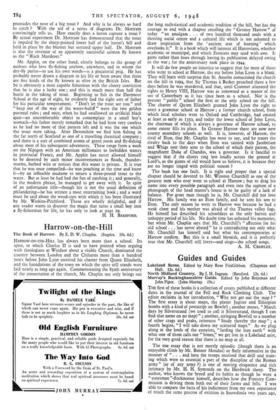Harrow-on-the-Hill
The Book of Harrow. By E. D. W. Chaplin. (Staples. 10s. 6d.) HARROW-ON-THE-HILL has always been more than a school. Its spire, to which Charles II is said to have pointed when arguing with theologians at Windsor about a visible Church, dominated the country between London and the Chilterns more than a hundred years before John Lyon received his charter from Queen Elizabeth, and the foundations of the town on which the spire still stands were laid nearly as long ago again. Commemorating the 85oth anniversary of the consecration of the church, Mr. Chaplin not only brings out
the long ecclesiastical and academic tradition of the hill, but has the courage to end with a chapter extolling the " Greater Harrow " of today " an amalgam . . . of two hundred thousand souls with a thriving social centre and a cultural life which is not ashamed to draw inspiration from the ' ancient seat of learning ' which overlooks it." It is a book which will interest all Harrovians, whether academic or municipal, and which Etonians may read with awe. It gains rather than loses through having its publication delayed owing to the war ; for the anniversary took place in 1944.
It will do few people an injustice to suggest that for most of those who went to school at Harrow, the era before John Lyon is a blank. They will learn with surprise that St. Anselm consecrated the church on the hill in 1094, that Sir Thomas a Becket preached there a few days before he was murdered, and that, until Cranmer alienated the rights to Henry VIII, Harrow was as renowned as a manor of the see of Canterbury as it has since been as a school. Nor is the present " public " school the first or the only school on- the hill. The charter of Queen Elizabeth granted John Lyon the right to erect a grammar school at Harrow ; a former church school, from which local scholars went to Oxford and Cambridge, had existed at least as early as 1350, and today the lower school of John Lyon, the chairman of which is always a governor of Harrow school, to some extent fills its place. In Greater Harrow there are now new county secondary schools as well. It is, however, of Harrow, the rival of Eton, that Mr. Chaplin has most to say, and he traces the rivalry back to the days when Eton was tainted with Jacobitism and Whigs sent their sons to the school of which their patron, the magnificent Duke of Chandos, was a governor. Is it fanciful to suggest that if the cheers ring less loudly across the ground at Lord's, as the giants of old would have us believe, it is because they are no longer tinged with political venom ?
The book has one fault. It is right and proper that a special chapter should be devoted to Mr. Winston Churchill as one of the greatest men who ever went to school at Harrow ; but to drag his name into every possible, paragraph and even into the caption of a photograph of the head master's house is to be guilty of a lack of balance. For great man though he is, Mr. Churchill did not love Harrow. His family was an Eton family, and he sent his son to Eton. The only reason he went to Harrow was because he had a weak chest and his mother was afraid of the Thames valley fogs. He himself has described his schooldays as the only barren and unhappy period of his life. No doubt time has softened his memories, but when Mr. Chaplin says that Mr. Churchill's " affection for his old school . . . has never abated " he is contradicting not only what Mr. Churchill has himself said but what his contemporaries at Harrow confirm. But this is a small blemish, and it is perfectly true that Mr. Churchill still loves—and sings—the school songs.
A. M. CRAWLEY.


































 Previous page
Previous page